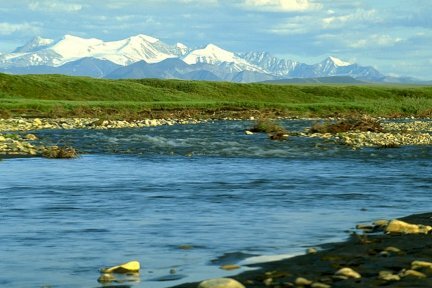
The Arctic National Wildlife Refuge
The Arctic National Wildlife Refuge(ANWR) is a vast, wild land that has been called America's Serengeti because of its diverse and thriving wildlife populations. The Refuge runs from the mountains of the Brooks Range north to the Arctic Ocean, including habitats such as tundra, boreal forest, barrier islands, and coastal lagoons.

The ANWR contains 19 million acres in remote northeastern Alaska. The oil companies want to open less than 1 percent, 12,700 acres to oil development. However all 12,700 acres are located on the coastal plain.
According to the US Fish & Wildlife Service, Oil and gas exploration and development would impact the fish and wildlife and their habitats, most notably caribou, muskoxen, polar bears, and migratory birds, as well as damage tundra vegetation and soils.
The Arctic National Wildlife Refuge is the most pristine unit in the National Wildlife Refuge System. Oil and gas exploration and development in the Refuge would permanently and irreversibly:
The effects of oil field development in the Arctic Refuge would extend far beyond the "footprint" of gravel pads and roads, and would cause many cumulative impacts including:
In late spring, just as the snow recedes and the tundra plants turn green, the Porcupine Caribou herd, numbering 129,000, migrates from south of the Brooks Range in the Arctic Refuge and Canada to give birth to their young on the arctic coastal tundra. Development in the 1002 Area would result in
A reduction in annual calf survival of as little as 5% would be sufficient to cause a decline in the Porcupine caribou population.
Muskoxen, Polarbears and 135 different species of birds also use the area that is being sought for oil development. Oil development in the Arctic Refuge would result in habitat loss, disturbance, and displacement or abandonment of important birthing, nesting, feeding areas. Displacement may result in potentially fatal human-bear conflicts.
The 1.5 million acre coastal plain of the Refuge -- the area where drilling would occur -- is the birthing and nursery grounds for the 130,000 member Porcupine Caribou herd, one of the hemisphere's largest caribou herds. This fragile coastal plain is the last 5% of the entire north slope of Alaska not already available to oil and gas exploration.
Environmental Orangaizations state that the biggest single step we can take is to make cars and trucks go farther on a gallon of gas.
According to the Union of Concerned Scientists, if SUVs met the same miles per gallon standard as cars, or at least 27.5 miles per gallon of gasoline, the United States could save one million barrels of oil a day. In a 10-year period -- the same amount of time it would take to bring Arctic Refuge oil to the lower 48 States -- the US could save 3.65 billion barrels of oil. That is more than the most likely total amount of economically recoverable oil in the coastal plain. Plus, these reductions in demand would last far longer than ten years, and would save consumers $45 billion a year!
Proponents of drilling in the Arctic Refuge claim that massive amounts of oil are to be found underneath the Refuge's fragile coastal plain. They often quote a figure of "technically recoverable oil" that might lie beneath the coastal plain. This is the amount of oil that could be recovered without any regard to cost. This figure does not take into account the actual cost of bringing the oil to domestic markets. When economic factors are considered, the amount of economically recoverable oil drops to just 3.2 billion barrels. The cost of drilling in the Arctic Refuge is so high, in fact, that the U.S. Geological Service (USGS) says if the price of oil fell to $16 a barrel, there would actually be NO economically recoverable oil in the coastal plain.
What do 3.2 billion barrels of oil mean to Americans? Each day, the United States consumes about 19.5 million barrels of oil, an annual total of about 7 billion barrels each year. At this rate of consumption, if Arctic oil was our nation's only source, it would fuel America's demand for less than 6 months.
US Fish & Wildlife Service
The Sierra Club (ANWR)
Alaska Conservation Foundation
The Gwich'in Indian Nation
National Geographic
The Washington Post
Arctic Circle: ANWR Special Report